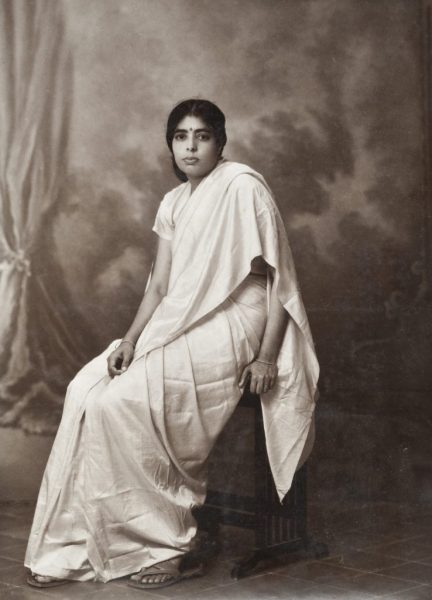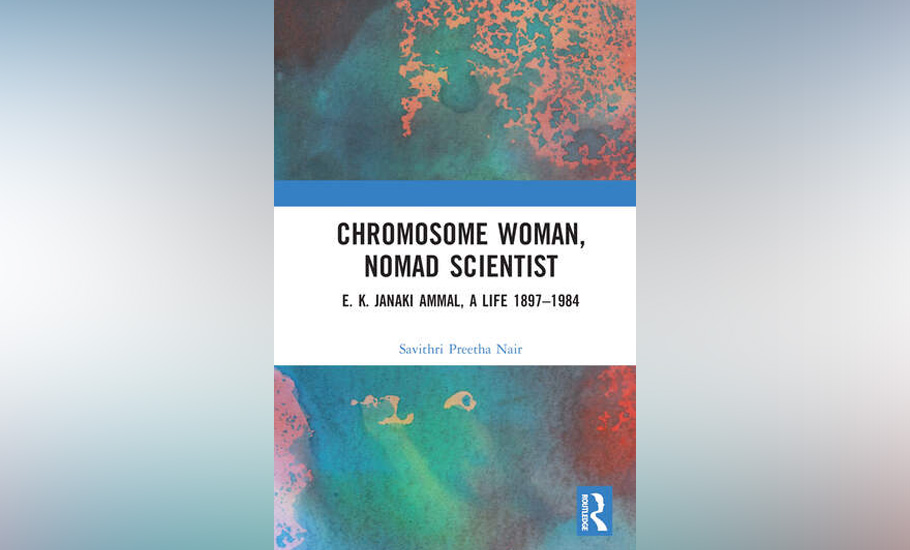
Book excerpt: EK Janaki Ammal, pioneering botanist, and an unsung genius

Chromosome Woman, Nomad Scientist: E. K. Janaki Ammal, A Life 1897-1984 by Savithri Preetha Nair is the first in-depth and analytical biography of the pioneering Asian woman scientist, whose life intersected with several significant historical events: the rise of Nazi Germany and World War II, the struggle for Indian Independence, the social relations of science movement, the Lysenko affair, the green revolution, the dawn of environmentalism and the protest movement against a proposed hydro-electric project in the Silent Valley in the 1970s and 1980s. This excerpt has been provided to The Federal by the author.
***
[In America]
After completing her training at Oak Ridge Nuclear Laboratory [May 1955], Janaki Ammal travelled north to Ann Arbor, Michigan, perhaps by air, where in early June, she was to receive a Legum Doctor (Doctor of Laws) from her alma mater, the University of Michigan, in recognition of her seminal contributions to botanical science.
It was Bartlett who had suggested her name to the committee on honorary degrees. He also had his department make a “reservation of Non-Resident Lecturer funds” for a lecture by Janaki during her stay at Ann Arbor. In late March that year, Janaki had received a letter from President Hatcher of the University inviting her to be the official guest of the University of Michigan at its commencement exercises on 11 June, and also to receive an honorary Doctor of Laws degree. She was “thrilled” to be so recognised by her alma mater, but wrote to Bartlett that she felt “quite unworthy of all this and even a bit worried at the publicity” this might bring her.
The Michigan Daily reported the news, and introduced her to the readers thus: “Edavaleth Kakkat Janaki, Director of the Central Botanical Laboratory, Government of India . . . has made herself an international reputation as a botanist of high order by her work in India, by her extensive research and writing and by her splendid contributions to important scientific conferences. . . Her Chromosome Atlas of Cultivated Plants, co-authored with C. D. Darlington, has become one of the great standard sources for cytological workers. Her extensive publications in the field of cytogenetics are widely respected. Blessed with the ability to make painstaking and accurate observations she and her patient endeavours stand as a model for serious and dedicated scientific workers.”

Janaki loathed publicity of any kind, much like her coeval McClintock [Nobel-prize winning maize cytogeneticist Barbara McClintock]; her excitement stemmed more from the thought of reuniting with old friends at Ann Arbor and walking about the botanic gardens, than anything else. Bartlett was “pleased about this honorary degree” and hoped “that the effect in India” would be favourable to her, but noted (engaging in his usual India bashing) that there was “such childish and silly antipathy to the United States” in India “that the result can hardly be expected to be altogether helpful. Too much politics and too little realistic thinking prevent good relations.” He was sure however that her friends and botanists “generally [were] going to view this degree as a well merited honour and . . . delighted” that it had gone to her.
Also read: I have always thought of a novel as an intimate space: Kamila Shamsie
[It is a pity that not one Indian institution bestowed Janaki with a similar honour when she was alive, not even the University of Madras, of which she was one of the earliest science graduates among women, and the most distinguished scientist till date.]
[In Britain]
That the Station [the Sugarcane Breeding Station, Coimbatore] had been using Janaki’s intergeneric hybrid as a parent to much benefit and for so long made her immensely happy, but it came also as a rude shock to her that the fact had been hidden from her all this time. It was clear that her work had been taken for granted: “I get no credit for all I have been doing — not even a mention. That is India! Don’t you think I deserve an FRS [Fellow of the Royal Society, London],” she would remark angrily. She was deeply unhappy that her work had gone unrecognised in her country, but the sad truth was that it was not very different elsewhere either. Given the great significance of her contributions to the field of evolutionary biology — plant cytogenetics, breeding and cytogeography — a good part of which was accomplished on British soil during the war, and its aftermath, she indeed deserved an FRS; had this happened, Janaki would have been the first ever ‘non-white’ or coloured woman scientist to have been so recognised by that great scientific institution, and deservedly so.
This was however not to be. As for Janaki’s Indian male contemporaries in the field of plant genetics, Panchanan Maheswari was conferred an FRS in 1965, and B. P. Pal and the much younger Swaminathan in 1972 and 1973, respectively. It would take seventy-five years for the Royal Society to elect an Indian woman (or of Indian extract) to the Royal Society as Fellow (the Royal Society began electing women as Fellows in 1945 [Kathleen Lonsdale and Marjory Stephenson (1945), Agnes Arber (1946), Mary Cartwright, Dorothy Hodgkin and Muriel Robertson (1947), Sidnie Manton and Dorothy Needham (1948) to name the first few, and of which only Arber was a botanist]; the first to be so recognised was Pratibha Gai in 2015, followed by the microbiologist Lalita Ramakrishnan in 2018, and the clinical scientist Gagandeep Kang in 2019.
[In India]
In 1977, when she was almost eighty, the Government of India finally decided to award Janaki a Padma Shri, the fourth-highest civilian award; a terribly belated recognition for the first Indian woman to be awarded a doctorate in the botanical sciences, the first woman to head a central government institution of science (the CBL of the BSI), the first such to be elected to scientific societies in India and abroad, the only Indian female presence at landmark international scientific conferences, and symposia even up until the 1960s, and perhaps the only practising Vavilovian evolutionary biologist and plant ecologist, male or female, in the country at this time, precociously aware of the need to conserve forests and genetic resources in general. It goes to show how little her science and its significance mattered to the powers that be; that she was a woman and a nomad didn’t help either.
The belated recognition is even more surprising given how close she was to Prime Minister Jawaharlal Nehru and V. K. Krishna Menon, in her capacity as a world-ranking expert in plant biology. Several male Indian botanists/agricultural scientists/geneticists (almost all of whom worked with her sometime or the other except perhaps M. S. Randhawa, and most with far less research experience or international exposure) had already been honoured with a Padma: T. S. Venkatraman (Padma Bhushan, 1956), Boshi Sen (Padma Bhushan, 1957), B. P. Pal (Padma Shri, 1958, Padma Bhushan, 1968), K. Ramiah (Padma Shri 1957, Padma Bhushan, 1970), N. Parthasarathy (Padma Shri, 1958), A. R. Gopal-Ayengar (Padma Shri, 1967), H. Santapau (Padma Shri, 1967), M. S. Randhawa (Padma Bhushan, 1972), M. S. Swaminathan (Padma Shri, 1967, Padma Bhushan, 1972) and T. S. Sadashivan (Padma Bhushan, 1974).
Also read: Delimitation will further erode South India’s political capital: Nilakantan RS
Speaking of the few women Padma awardees prior to 1977, these were chiefly in recognition of their contribution to ‘public affairs,’ ‘civil service,’ ‘literature and education,’ ‘arts’ and ‘social work’; a few went to the field of medicine (nursing chiefly, but one to a doctor), one to sports (Arati Saha, Padma Shri, 1960), and only two to scientists: Savitri Sahni (Padma Shri, 1969, as science administrator rather than for a direct contribution to science), and Asima Chatterjee born 1917 (Padma Bhushan, 1975: earned her doctorate in chemistry in 1944 from the University of Calcutta). Perhaps, Janaki (born 1897: earned her doctorate in 1931 from the University of Michigan) took consolation from Mary Poonen Lukose (1886-1976), from her home state of Kerala, who was the first woman Surgeon General in India, but was awarded the Padma Shri as late as 1975, just a year before she died, at the age of ninety!
Savithri Preetha Nair is a historian of science and an independent scholar based in London and Kerala. Among her publications is the co-authored (with Richard Axelby) Science and the Changing Environment in India: A Guide to Sources in the India Office Records 1780–1920 (British Library, London, 2010) and Raja Serfoji II: Science, Medicine and Enlightenment in Tanjore, 1786–1832 (Routledge India, 2012).

